![]()
![]()
![]()
Use LEFT and RIGHT arrow keys to navigate between flashcards;
Use UP and DOWN arrow keys to flip the card;
H to show hint;
A reads text to speech;
68 Cards in this Set
- Front
- Back
|
What is photosynthesis:
|
1. the combining of carbon dioxide in the atomosphere with existing sugars to make the carbon in the atom available to the plants.
2. Carbon dioxide is fixed into sugar 3. 6CO2 + 12H2O + light energy --> C6H12O2 + 6H2O [happens in chloroplast, driven by light] |
|
|
Why is photosynthesis important?
|
1. the only way to fix carbon atom into organic form
2. oxygen "waste" creates the oxygen in the atmosphere 3. oxygen in the atmosphere reacted to form ozone which then formed the ozone layer |
|
|
Do plants carry out oxidative respiration?
|
Yes
since plants carry out both oxidative respiration and photosynthesis, that makes plants photoautotrophs. |
|
|
Photoautotrophs:
|
feed themselves with light.
|
|
|
Where does photosynthesis occur?
|
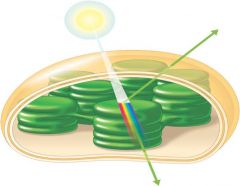
1. occurs in the parenchymal cells of the mesophyll, epidermal cells of leaves and occasionally stems.
2. specifically it occurs in the chloroplasts of these cells |
|
|
Chloroplast:
|
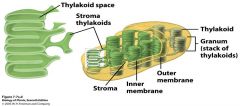
double membrane bound, giving rise to several sub-cellular compartments.
|
|
|
functions of the outer membrane of the chloroplast?
|
- barrier to cytoplast serves to retain chlorophyll content.
- does have transport proteins that move photosynthate to cytoplast for glycolysis. |
|
|
functions of the inner membrane of the chloroplast?
|
- barrier to stroma, serves to retain chlorophyll contents
- has transport protein to move photoynthate to intermembrane space. |
|
|
function of the intermembrane space:
|
function is still unknown
|
|
|
stroma:
|
is the site of carbon dioxide fixation
|
|
|
thylakoid membrane (component of grana):
|
is the site of embedded antenna chlorophyll molecules and light reaction components and ATP sythase.
|
|
|
Thylakoid space:
|
store of H+ (i.e. chemiosmotic potential) that is used to drive the ATP synthase of thylakoid.
|
|
|
how chloroplast develop?
|
1. preplastids (embroyonic plastids) are received form embryo.
2. preplastids develop along different developmental pathways in response to signals to become either chloroplasts or chromoplasts. 3. there are some interconversion as chloroplasts can become chromoplasts in the fall as leaves change color and are dropped. |
|
|
chromoplasts:
|
pigment bearing plastids
|
|
|
photosynthesis equation:
|

[note glucose is not really the direct product of photosynthesis]
|
|
|
during photosynthesis, the "waste" oxygen gas is derived from?
|
the water, which reinforces the idea that photosynthesis is a redox reaction.
- reduction is adding electrons and oxidation is removal of electrons, - when water is split, H+ and electrons are removed from O, the causes the O to bond with C making the sugar compound. |
|
|
Photosynthesis is really just the opposite of?
|

oxidative respiration
|
|
|
Light reactions:
|

- uses light energy to make ATP and NADPH(the anabolic form of NADH)
- has similariites to the electron transport system - Uses water as a source of electrons and releases oxygen gas as waste |
|
|
Calvin-Benson Cycle (aka: dark reactions):
|
uses the ATP and NADPH from light reactions to fix carbon dioxide into sugar.
|
|
|
Is light a wave or a particle?
|
it has the properties of both
|
|
|
Light is a form of?
|
radiation
|
|
|
The greater the wavelength, the ________ the energy level?
|
lower
|
|
|
Light radiation is radiation between what nm?
|
~380nm - ~750nm
|
|
|
different wavelengths of light have different colors
|
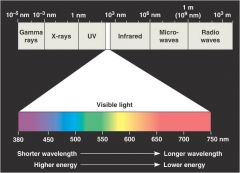
|
|
|
Why is the sunlight that you see white?
|
because it is a mixture of all wavelengths
|
|
|
Why do we say that light is like a particle too?
|
the energy that light contains is quantized (energy acts as if it is in discrete packages [photons] and discrete quantities)
- we know the amount of energy in light is inversely related to wavelength. (certain wavelengths have a certain energy) |
|
|
Why do substances absorb some light wavelengths and not others?
|
- depends on the absorbing substance
- when a substance absorbs light, it is called a pigment and it interacts in a specific way with the light. - For a specific wavelength of light to be absorbed, it must have the specific energy necessary to kick an electron from one specific orbital to a higher specific energy orbital in that substance. |
|
|
Light can be reflected, what does that mean?
|
that it bounces off
|
|
|
Light can be transmitted, what does that mean?
|
it passes on through.
|
|
|
Light can be absorbed, what does that mean?
|
its energy is transferred to the substance. or its energy is transferred to the substance and partly re-emitted as fluorescent light.
|
|
|
What is happening to the light when you see a green leaf?
|
- green light (and yellow) is reflected and transmitted.
- red and blue are absorbed (the colors you see are the colors that are reflected and transmitted. The colors you don't see are absorbed) |
|
|
Chlorophyll:
|
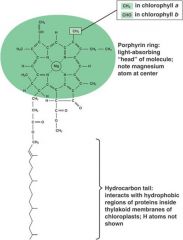
most common are Chl(a) & Chl(b)
- very similar but have absorption max at slightly diff. wavelengths |
|
|
What happens to chlorophyll when struck by blue or red light?
|
- specific electrons of the Mg are kicked up an energy level.
note:: blue light has more energy than red, but both can jump an electron of Mg up an energy level. |
|
|
What happens to the electron in the chlorphyll?
|
very quickly, the electron drops back to the ground state
|
|
|
What 4 things can happen to the energy released as the electron drops?
|
1. energy can be given off as heat (helps keep plant from freezing)
2. energy can be given to another molecule (another chlorphyll) 3. energy can be given off as fluorescent light (a) usually when there is no other molecule to pass the energy to (b) photon emitted will be at a lower energy than the original photon due to heat loss 4. Energy can be transferred in a chemical reaction. |
|
|
Absorption spectrum:
|
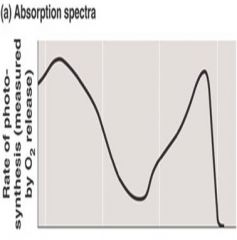
spectrum which shows all the light absorbed by the plant pigments.
|
|
|
Does the plant use the other wavelengths of light?
|
yes but use acessory pigments (Chl(b), carotinoids, xanophylls), to absorb light of different wavelengths and pass the energy to Chl(a).
happens at lower efficiency. |
|
|
Action Spectrum:
|
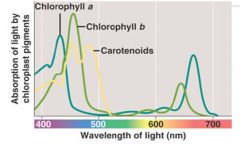
the absorption wavelengths of light that will drive photosynthesis.
|
|
|
Will the absorption spectrum match the action spectrum?
|
- No, the absorption spectrum of chlorphyll a does not match the action spectrum,
- but the absorption spectrum of all the photopigments combined will more or less match the action spectrum. |
|
|
How was the action spectrum determined?
|
By the Engelmann's Experiment:
- took a piece of filamentous algae and laid it out striaght. - shined light through a prism to produce a spectrum and projected it along the length of the algal filament. - billions of motile aerobic bacteria (need dioxide to carry out ox. resp) were added. - bacteria moved to the red and blue regions, showing that red and blue are the wavelengths that drive photosynthesis. |
|
|
Photosystems:
|
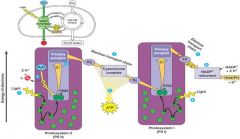
molecular systems in an organized array that absorbs light and transfers energy to other molecules that are useful for the system.
|
|
|
Antenna Complexes:
|
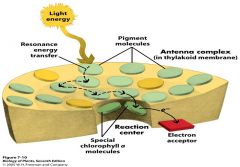
- composed of the antenna molecules, which are the photopigments [chl(a), chl(b), carotinoid, ...]
- molecules are arranged in an array embedded in the thylakoid membrane, and are spread out to maximize absorption. |
|
|
In the antenna complex, what energy transfers occurs?
|
quantum energy transfer
|
|
|
What happens when blue or red light strikes an antenna molecule?
|
1. red/blue light is absorbed by an antenna molecule.
2. the energy is transferred as a quantum of energy to a neighbor antenna molecule (photopigment) 3. the neighbor antenna molecule passes the energy to another neighbor molecules until eventually the energy is passed to the reaction center molecule. |
|
|
Photosystem II:
|
1. starts with an antenna complex with a reaction center containing a chl(a) called P680, along with electron transfer molecules.
2. light is absorbed by antenna molecules, energy is passed to other photopigment molecules by quantum transfer. 3. eventually the energy reaches chl(a) P680 where the quantized energy is absorbed. 4. energy is used to bump up the energy level of specific e- in Mg2+ of P680 by a specific amount. 5. the energized e- are donated to an acceptor molecule [ reduces the primary electron acceptor] 6. e- that the primary acceptor has accepted is high and unstable, the donated e- are easily passed to quinone [an e- transfer compound very similar to electron transport system] 7. e- are further transfered along an electron transfer sys. pathway until they are donated to P700 of photosystem I. |
|
|
how does photosystem II looks:
|
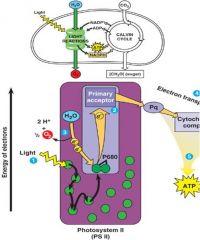
|
|
|
When e-'s are passed down the electron transport system of ox. resp. to dioxide, what is generated?
|
a chemiosmotic potential
|
|
|
what is a chemiosmotic potential?
|
protons get pumped out.
|
|
|
How does photosystem II actually produce a chemiosmotic potential?
|

- PSII cytochromes are energized
- PSII cytochromose pump protons from the stroma, across the thylakoid membrane, and into the thylakoid space. |
|
|
What harnesses the chemiosmotic potential and how?
|
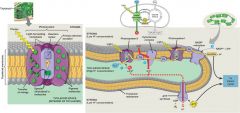
The ATPases
- it allows the diffusion of protons back into the stroma and uses that energy to make ATP. |
|
|
Where do the electrons come from if plants keep removing electrons from P680 to feed the electron transport system?
|
through photolysis of water
[the splitting or decomposition of a chemical compound by means of light energy or photons.] - water is split into H+, oxygen, and electrons by an enzyme - the electrons are used to replenish P680 - oxygen is generated. (how plants make oxygen) |
|
|
Photosystem I:
|
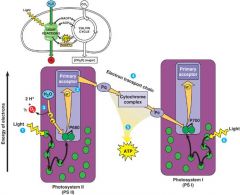
- The e-s from PSII are donated to P700 of PSI.
- when a red or blue photon is captured by PSI antenna complex and then transferred to P700, the red or blue light elevates the energy level of e-s in Mg2+ in P700. - high energy e-s are donated to an e- acceptor (Fd) in a process like PSII, -->but then the Fd donates the e-'s to an enzyme [NADP reductase] - NADP reductase takes the e-'s and a stromal proton and combines them with NADP to make NADPH. |
|
|
Review of light reactions:
|
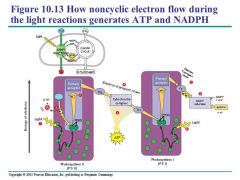
products processed:
- ATP - NADPH - oxygen [waste product] |
|
|
Plants most commonly use light reactions to generate what? which fixes what?
|
generates ATP and NADPH to fix carbon dioxide into a reduced form (sugar) that can be used in ox. phos. and biosynthesis.
|
|
|
Where does the Calvin-Benson cycle occur? and does it use light directly?
|
it doesn't use light directly and it occurs in the stroma.
|
|
|
summary equation of the Calvin-Benson cycle:
|

|
|
|
Where does the carbon from carbon dioxide goes in the calvin-benson cycle?
|
it goes to PGA
|
|
|
What techniques were used in the discovery of the calvin-benson cycle?
|
- TLC [ thin layer chromotography]
- autoradiography - radioactive isotopes [ b/c radioactive elements are easily introduced into living things, and enzymes can't tell the difference between regular isotopes and readioactive isotopes.. can therefore be traced and tracked] |
|
|
Pulse-chase experiment [ the discovery of the calvin-benson cycle]:
|
- placed algae in a flask and fed it carbon dioxide 14 for a very short period of time (pulse) and then gave it carbon dioxide 12 (chase)
[only products made when exposed to carbon dioxide 14 will have radioactive carbon incorporated. - they extracted the organic chemicals from the algae, ran the extract out on the TLC sheet and autoradiographed the sheet. - The largest spot on the autoradiogram turned out to be a C3 compound (3-PGA). |
|
|
C3 pathway:
|
uses 5C + 1C= 3C x 2
reduction product: C3 compound. |
|
|
What is the enzyme that carries out the C3 pathway reaction:
|

Rubisco
|
|
|
What are some notes about carbon fixation?
|
1. occurs without light
2. occurs in solution of the stroma 3. doesn't add carbon dioxide to a C2 to make a 3-PGA 4. Rubisco is the most abundant enzyme by weight in the world and possibly the most common protein. |
|
|
What are the 3 distinct phases the Calvin-Benson cycle is divided up into?
|
1. the [carbon fixation] which is carried out by rubisco
2. the [reduction phase] which causes the carbon to be reduced further 3. the [regeneration phase] where RuBP is regenerated |
|
|
Phase 1: Carbon fixation:
|
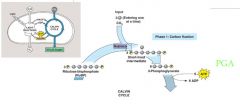
|
|
|
Phase 2: Reduction phase:
|
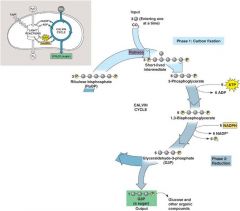
1. e-'s are added to a triose-P to generate GAP.
2. uses up NADPH and ATP |
|
|
What is GAP?
|
- a compound that is an intermediate that can be shuttled among many pathways including oxidation phosphorelation.
|
|
|
Phase 3: regeneration phase:
|
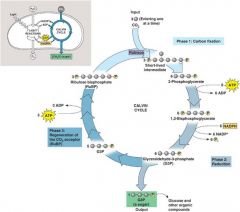
1, RuBP is reformed so that the CO2 fixation steps can occur again.
2. uses ATP [takes 5 GAPs & turning it into RuBP... 5 x 3C = 3 x 5C(RuBP)] |
|
|
What are some examples of plants that use the C3 pathway to fix carbon dioxide?
|
- wheat
- rice -soy |

